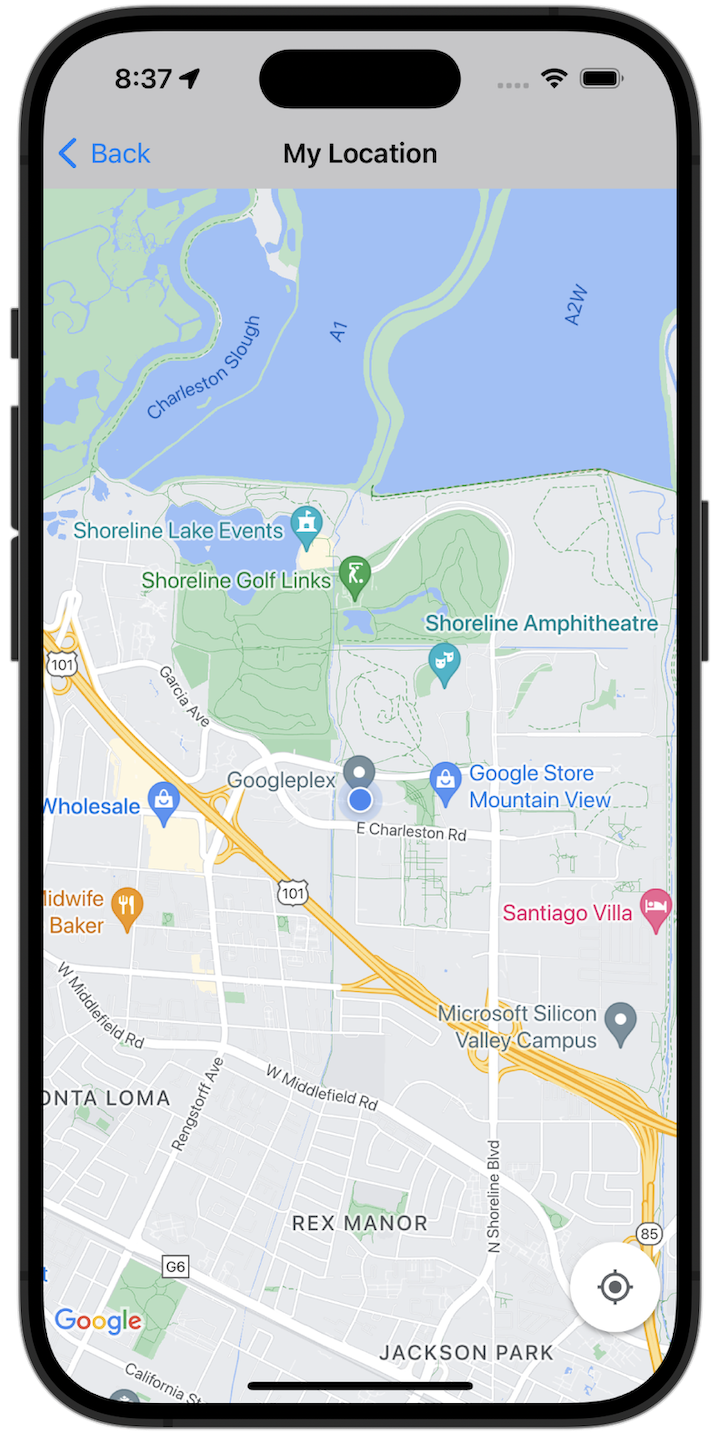
Comenzar
Antes de probar el código de muestra, debes configurar tu entorno de desarrollo. Para obtener más información, consulta Muestras de código del SDK de Maps para iOS.
Consulta el código
Swift
import GoogleMaps import UIKit class MyLocationViewController: UIViewController { private let cameraLatitude: CLLocationDegrees = -33.868 private let cameraLongitude: CLLocationDegrees = 151.2086 private let cameraZoom: Float = 12 lazy var mapView: GMSMapView = { let camera = GMSCameraPosition( latitude: cameraLatitude, longitude: cameraLongitude, zoom: cameraZoom) return GMSMapView(frame: .zero, camera: camera) }() var observation: NSKeyValueObservation? var location: CLLocation? { didSet { guard oldValue == nil, let firstLocation = location else { return } mapView.camera = GMSCameraPosition(target: firstLocation.coordinate, zoom: 14) } } override func viewDidLoad() { super.viewDidLoad() mapView.delegate = self mapView.settings.compassButton = true mapView.settings.myLocationButton = true mapView.isMyLocationEnabled = true view = mapView // Listen to the myLocation property of GMSMapView. observation = mapView.observe(\.myLocation, options: [.new]) { [weak self] mapView, _ in self?.location = mapView.myLocation } } deinit { observation?.invalidate() } } extension MyLocationViewController: GMSMapViewDelegate { func mapView(_ mapView: GMSMapView, didTapMyLocation location: CLLocationCoordinate2D) { let alert = UIAlertController( title: "Location Tapped", message: "Current location: <\(location.latitude), \(location.longitude)>", preferredStyle: .alert) alert.addAction(UIAlertAction(title: "OK", style: .default)) present(alert, animated: true) } }
Objective-C
#import "GoogleMapsDemos/Samples/MyLocationViewController.h" #import <GoogleMaps/GoogleMaps.h> @implementation MyLocationViewController { GMSMapView *_mapView; BOOL _firstLocationUpdate; } - (void)viewDidLoad { [super viewDidLoad]; GMSCameraPosition *camera = [GMSCameraPosition cameraWithLatitude:-33.868 longitude:151.2086 zoom:12]; _mapView = [GMSMapView mapWithFrame:CGRectZero camera:camera]; _mapView.delegate = self; _mapView.settings.compassButton = YES; _mapView.settings.myLocationButton = YES; // Listen to the myLocation property of GMSMapView. [_mapView addObserver:self forKeyPath:@"myLocation" options:NSKeyValueObservingOptionNew context:NULL]; self.view = _mapView; // Ask for My Location data after the map has already been added to the UI. GMSMapView *mapView = _mapView; dispatch_async(dispatch_get_main_queue(), ^{ mapView.myLocationEnabled = YES; }); } - (void)mapView:(GMSMapView *)mapView didTapMyLocation:(CLLocationCoordinate2D)location { NSString *message = [NSString stringWithFormat:@"My Location Dot Tapped at: [lat: %f, lng: %f]", location.latitude, location.longitude]; UIAlertController *alertController = [UIAlertController alertControllerWithTitle:@"Location Tapped" message:message preferredStyle:UIAlertControllerStyleAlert]; UIAlertAction *okAction = [UIAlertAction actionWithTitle:@"OK" style:UIAlertActionStyleDefault handler:^(UIAlertAction *action){ }]; [alertController addAction:okAction]; [self presentViewController:alertController animated:YES completion:nil]; } - (void)dealloc { [_mapView removeObserver:self forKeyPath:@"myLocation" context:NULL]; } #pragma mark - KVO updates - (void)observeValueForKeyPath:(NSString *)keyPath ofObject:(id)object change:(NSDictionary *)change context:(void *)context { if (!_firstLocationUpdate) { // If the first location update has not yet been received, then jump to that location. _firstLocationUpdate = YES; CLLocation *location = [change objectForKey:NSKeyValueChangeNewKey]; _mapView.camera = [GMSCameraPosition cameraWithTarget:location.coordinate zoom:14]; } } @end
Ejecuta la app de ejemplo completa de forma local
La app de ejemplo del SDK de Maps para iOS está disponible como un archivo de descarga en GitHub. Sigue estos pasos para instalar y probar la app de ejemplo del SDK de Maps para iOS.
- Ejecuta
git clone https://github.com/googlemaps-samples/maps-sdk-for-ios-samples.gitpara clonar el repositorio de muestras en un directorio local. Abre una ventana de terminal, navega al directorio en el que clonaste los archivos de muestra y, luego, profundiza en el directorio GoogleMaps:
Swift
cd maps-sdk-for-ios-samples/GoogleMaps-Swift
open GoogleMapsSwiftXCFrameworkDemos.xcodeprojObjective-C
cd maps-sdk-for-ios-samples-main/GoogleMaps
open GoogleMapsDemos.xcodeproj- En el proyecto de Xcode, ve a File > Add Package Dependencies.
Ingresa
https://github.com/googlemaps/ios-maps-sdkcomo la URL, presiona Intro para extraer el paquete y haz clic en Agregar paquete. - En Xcode, presiona el botón de compilación para compilar la app con el esquema actual. La compilación produce un error que te solicita que ingreses tu clave de API en el archivo
SDKConstants.swiftpara Swift o en el archivoSDKDemoAPIKey.hpara Objective-C. - Obtén una clave de API de tu proyecto con el SDK de Maps para iOS habilitado.
- Edita el archivo
SDKConstants.swiftpara Swift o el archivoSDKDemoAPIKey.hpara Objective-C y pega tu clave de API en la definición de la constanteapiKeyokAPIKey. Por ejemplo:Swift
static let apiKey = "YOUR_API_KEY"Objective-C
static NSString *const kAPIKey = @"YOUR_API_KEY";
- En el archivo
SDKConstants.swift(Swift) oSDKDemoAPIKey.h(Objective-C), quita la siguiente línea, ya que se usa para registrar el problema definido por el usuario:Swift
#error (Register for API Key and insert here. Then delete this line.)
Objective-C
#error Register for API Key and insert here.
- Compila y ejecuta el proyecto. Aparecerá la ventana del simulador de iOS, que muestra una lista de Maps SDK Demos.
- Elige una de las opciones que se muestran para experimentar con una función del SDK de Maps para iOS.
- Si se te solicita que permitas que GoogleMapsDemos acceda a tu ubicación, elige Permitir.

